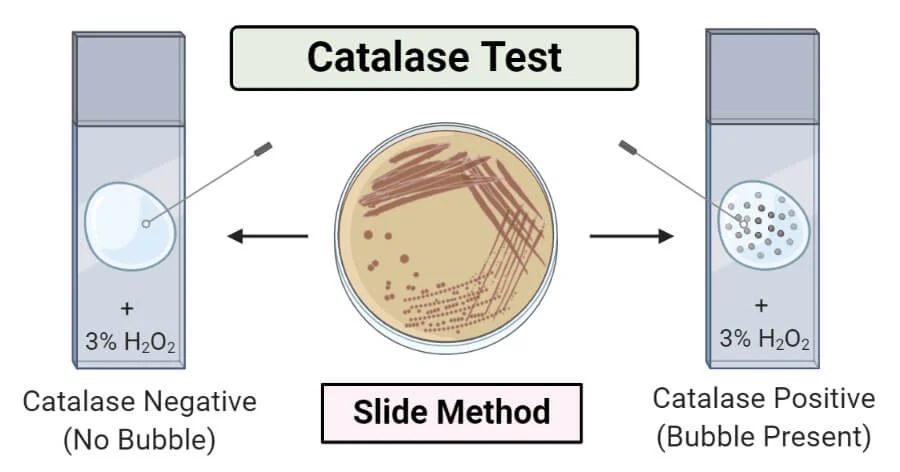What is Catalase test?

The catalase test is a straightforward biochemical assay used to determine whether a microorganism produces the enzyme catalase. Catalase plays a crucial role in protecting cells from oxidative damage by breaking down hydrogen peroxide a harmful byproduct of oxygen metabolism into water and oxygen. In this test, when hydrogen peroxide is added to a bacterial sample, the immediate formation of bubbles indicates a positive result, signifying the presence of catalase. This reaction is instrumental in differentiating between catalase-positive organisms, such as Staphylococcus species, and catalase-negative ones, like Streptococcus species.
Summary of Catalase test
- The catalase test detects the presence of the enzyme catalase, which breaks down hydrogen peroxide into water and oxygen.
- It helps differentiate catalase-positive bacteria (like Staphylococcus) from catalase-negative bacteria (like Streptococcus).
- A positive result shows bubbling due to oxygen release, while a negative result shows little to no bubbles.
Table of Contents
Principle of Catalase test
The catalase test is a simple biochemical assay used to detect the presence of the enzyme catalase in microorganisms. Catalase catalyzes the decomposition of hydrogen peroxide (H₂O₂) into water and oxygen,
2H₂O₂ → 2H₂O + O₂ (gas)
When hydrogen peroxide is added to a culture of bacteria, the immediate formation of bubbles indicates the presence of catalase, signifying a positive result. This reaction helps differentiate between catalase-positive and catalase-negative organisms.
Procedure of Catalase examination
There are two common methods to perform the catalase test:
Slide Method
- Place a drop of 3% hydrogen peroxide on a clean glass slide.
- Using a sterile loop or wooden stick, transfer a small amount of the bacterial colony onto the drop.
- Observe for the immediate formation of bubbles.
Tube Method
- Add 1–2 ml of 3% hydrogen peroxide into a test tube.
- Using a sterile loop, introduce a small amount of the bacterial culture into the solution.
- Look for the rapid appearance of bubbles.
Types of Catalase examination
- Qualitative Catalase Test: Determines the presence or absence of catalase enzyme based on bubble formation.
- Semi-Quantitative Catalase Test: Measures the intensity of the reaction, often used for identifying certain species like Mycobacterium tuberculosis.
- Heat-Stable Catalase Test: Used to differentiate between species of Mycobacterium based on their catalase activity after heating.
Results Interpretation of Catalase examination

- Positive Result: Immediate and vigorous bubbling indicates the presence of catalase enzyme.
- Negative Result: No bubbling or very minimal bubble formation suggests the absence of catalase.
Uses of Catalase Test
- Differentiation of Bacterial Species: Helps distinguish between catalase-positive organisms like Staphylococcus and catalase-negative ones like Streptococcus.
- Identification of Aerobic vs. Anaerobic Bacteria: Aerobic and facultatively anaerobic bacteria typically produce catalase, whereas obligate anaerobes do not.
- Diagnosis of Mycobacterial Infections: Assists in identifying species of Mycobacterium based on their catalase activity.
- Quality Control in Laboratories: Ensures the accuracy of bacterial identification procedures.
Precautions of Catalase examination
- Avoid using metal loops, as they can catalyze the decomposition of hydrogen peroxide, leading to false-positive results.
- Do not perform the test on blood agar plates, as red blood cells contain catalase, which can also cause false positives.
- Use fresh bacterial cultures (18–24 hours old) to ensure accurate results.
The catalase test is a fundamental tool in microbiology, offering a quick and reliable method to differentiate bacterial species based on their enzymatic activity. Its simplicity and effectiveness make it an essential procedure in clinical diagnostics and microbiological research.
Conclusion
In the intricate realm of microbiology, the catalase test emerges as a beacon of simplicity and efficacy. This straightforward assay not only distinguishes between catalase-producing and non-producing bacteria but also offers profound insights into microbial physiology. By observing the effervescence resulting from the breakdown of hydrogen peroxide, scientists can swiftly identify and classify bacterial species, streamlining diagnostic processes and advancing our understanding of microbial behavior.
The elegance of the catalase test lies in its rapidity and reliability. With just a drop of hydrogen peroxide and a bacterial sample, one can witness a bubbling reaction that speaks volumes about the organism’s enzymatic capabilities. This immediate visual cue not only aids in clinical diagnostics but also underscores the dynamic nature of microbial life and its adaptive mechanisms to oxidative stress.
As we delve deeper into the microscopic world, tools like the catalase test remind us of the profound narratives hidden within simple reactions. They serve as a testament to the wonders of microbiology, where even the most unassuming tests can unveil critical information, guiding research, diagnostics, and our broader comprehension of the microbial universe.
Frequently Asked Questions (FAQs)
What Does a Positive Catalase Test Indicate?
A positive result is characterized by the rapid formation of oxygen bubbles when hydrogen peroxide is applied to the bacterial culture. This indicates the presence of catalase enzyme, suggesting the organism is capable of breaking down hydrogen peroxide.
What Does a Negative Catalase Test Indicate?
The absence of bubble formation upon the addition of hydrogen peroxide suggests a negative result. This implies that the organism does not produce catalase and cannot decompose hydrogen peroxide effectively.
Why is the Catalase Test Important in Microbiology?
It is crucial for differentiating between bacterial species, especially those with similar morphological characteristics. For instance, it helps distinguish Staphylococcus species (catalase-positive) from Streptococcus species (catalase-negative), aiding in accurate bacterial identification and diagnosis.
Related Articles




